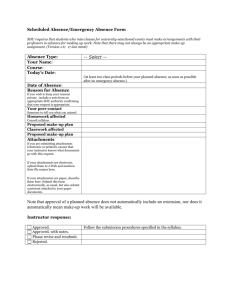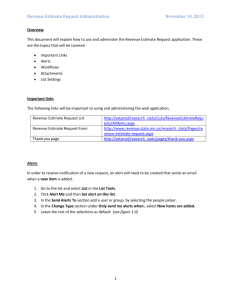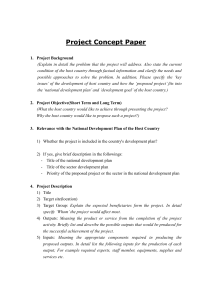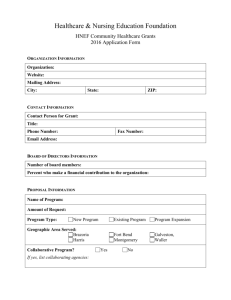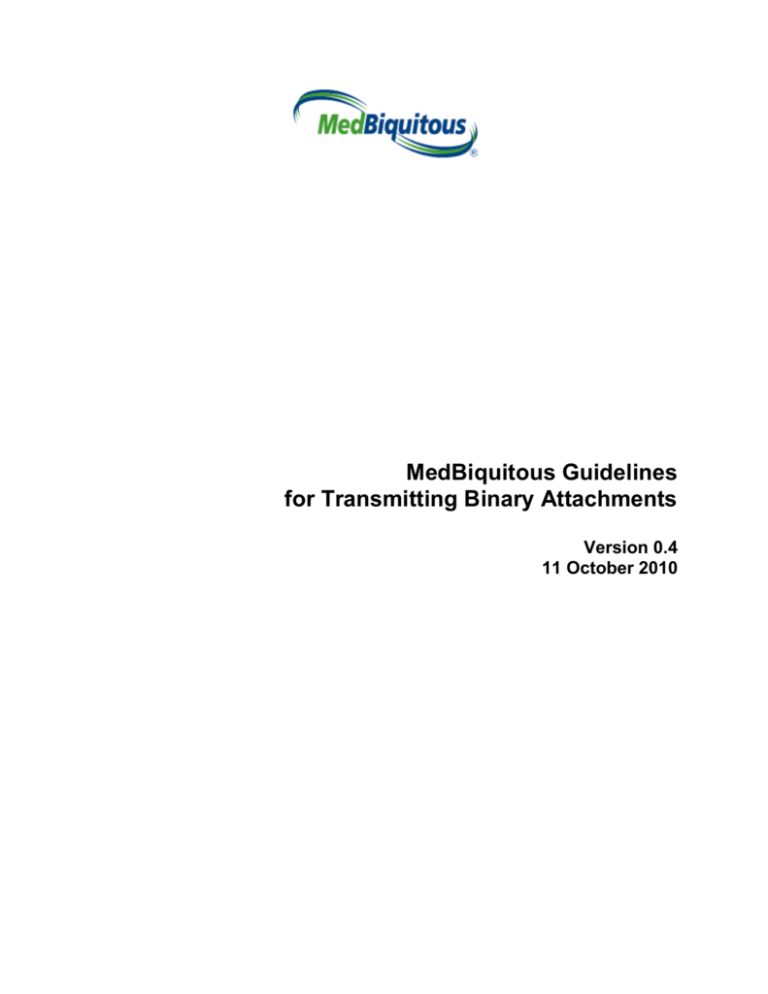
MedBiquitous Guidelines
for Transmitting Binary Attachments
Version 0.4
11 October 2010
MedBiquitous
MedBiquitous Guidelines for transmitting Binary Attachments
Version:
0.4
Date: October 11, 2010
Revision History
Date
__, 2010
Version
1.0
Description
Initial release
Author
Valerie Smothers
vsmothers@medbiq.org
MedBiquitous, 2016
Page 2
MedBiquitous
MedBiquitous Guidelines for transmitting Binary Attachments
Version:
0.4
Date: October 11, 2010
Table of Contents
MedBiquitous Consortium XML Public License and Terms of Use
4
1.
Acknowledgement
5
2.
Scope
5
3.
Status
5
4.
Introduction
5
5.
Transmitting Binary Attachments Using SOAP Web Services
5
6.
Transmitting Binary Attachments using MIME Encoding
6
7.
Transmitting Binary Attachments Referencing a Shared Location
7
8.
References
MedBiquitous, 2016
12
Page 3
MedBiquitous
MedBiquitous Guidelines for transmitting Binary Attachments
Version:
0.4
Date: October 11, 2010
MedBiquitous Consortium XML Public License and Terms of Use
MedBiquitous XML (including schemas, specifications, sample documents, Web services description files, and
related items) is provided by the copyright holders under the following license. By obtaining, using, and or copying
this work, you (the licensee) agree that you have read, understood, and will comply with the following terms and
conditions.
The Consortium hereby grants a perpetual, non-exclusive, non-transferable, license to copy, use, display, perform,
modify, make derivative works of, and develop the MedBiquitous XML for any use and without any fee or royalty,
provided that you include the following on ALL copies of the MedBiquitous XML or portions thereof, including
modifications, that you make.
1.
2.
3.
Any pre-existing intellectual property disclaimers, notices, or terms and conditions. If none exist, the
following notice should be used: “Copyright © [date of XML release] MedBiquitous Consortium. All
Rights Reserved. http://www.medbiq.org”
Notice of any changes or modification to the MedBiquitous XML files.
Notice that any user is bound by the terms of this license and reference to the full text of this license in a
location viewable to users of the redistributed or derivative work.
In the event that the licensee modifies any part of the MedBiquitous XML, it will not then represent to the public,
through any act or omission, that the resulting modification is an official specification of the MedBiquitous
Consortium unless and until such modification is officially adopted.
THE CONSORTIUM MAKES NO WARRANTIES OR REPRESENTATIONS, EXPRESS OR IMPLIED, WITH
RESPECT TO ANY COMPUTER CODE, INCLUDING SCHEMAS, SPECIFICATIONS, SAMPLE
DOCUMENTS, WEB SERVICES DESCRIPTION FILES, AND RELATED ITEMS. WITHOUT LIMITING THE
FOREGOING, THE CONSORTIUM DISCLAIMS ANY IMPLIED WARRANTIES OF MERCHANTABILITY
OR FITNESS FOR A PARTICULAR PURPOSE AND ANY WARRANTY, EXPRESS OR IMPLIED, AGAINST
INFRINGEMENT BY THE MEDBIQUITOUS XML OF ANY THIRD PARTY PATENTS, TRADEMARKS,
COPYRIGHTS OR OTHER RIGHTS. THE LICENSEE AGREES THAT ALL COMPUTER CODES OR
RELATED ITEMS PROVIDED SHALL BE ACCEPTED BY LICENSEE “AS IS”. THUS, THE ENTIRE RISK
OF NON-PERFORMANCE OF THE MEDBIQUITOUS XML RESTS WITH THE LICENSEE WHO SHALL
BEAR ALL COSTS OF ANY SERVICE, REPAIR OR CORRECTION.
IN NO EVENT SHALL THE CONSORTIUM OR ITS MEMBERS BE LIABLE TO THE LICENSEE OR ANY
OTHER USER FOR DAMAGES OF ANY NATURE, INCLUDING, WITHOUT LIMITATION, ANY
GENERAL, DIRECT, INDIRECT, INCIDENTAL, CONSEQUENTIAL, OR SPECIAL DAMAGES, INCLUDING
LOST PROFITS, ARISING OUT OF ANY USE OF MEDBIQUITOUS XML.
LICENSEE SHALL INDEMNIFY THE CONSORTIUM AND EACH OF ITS MEMBERS FROM ANY LOSS,
CLAIM, DAMAGE OR LIABILITY (INCLUDING, WITHOUT LIMITATION, PAYMENT OF ATTORNEYS’
FEES AND COURT COSTS) ARISING OUT OF MODIFICATION OR USE OF THE MEDBIQUITOUS XML
OR ANY RELATED CONTENT OR MATERIAL BY LICENSEE.
LICENSEE SHALL NOT OBTAIN OR ATTEMPT TO OBTAIN ANY PATENTS, COPYRIGHTS OR OTHER
PROPRIETARY RIGHTS WITH RESPECT TO THE MEDBIQUITOUS XML.
THIS LICENSE SHALL TERMINATE AUTOMATICALLY IF LICENSEE VIOLATES ANY OF ITS TERMS
AND CONDITIONS.
MedBiquitous, 2016
Page 4
MedBiquitous
MedBiquitous Guidelines for transmitting Binary Attachments
Version:
0.4
Date: October 11, 2010
MedBiquitous Guidelines for Transmitting Binary
Attachments
1.
Acknowledgement
These guidelines are based on work submitted by Joel Farrell of IBM, Chair of the MedBiquitous Technical Steering
Committee. The following members of the MedBiquitous Technical Steering Committee also contributed to this
document:
2.
James Fiore, American Board of Surgery
Steve Kenney, American Osteopathic Association
Dan Rehak, Learning Technologies Architect
Andy Rabin, CECity
Carl Singer, CECity
Valerie Smothers, MedBiquitous
Scope
This document provides general guidelines for those wishing to transmit binary attachments to support XML
documents. The document provides guidance for transmission via SOAP-based web services, via Representational
State transfer (REST) services, and other types of transmission, including the transmission of zip files.
3.
Status
This document is a technical guideline developed for the MedBiquitous community. It is currently a draft document;
we welcome your comments. These guidelines are designed to complement the MedBiquitous Web Services Design
Guidelines [MedBiq1] and the Knowing When to REST: Simple Object Access Protocol vs. Representational State
Transfer [MedBiq2].
4.
Introduction
There are many instances where it is necessary to transmit supporting documents as file attachments that accompany
structured XML data. For example, some hospitals may wish to receive a copy of a physician’s diploma when
making decisions about whether or not to grant privileges to the physician. Because the need to transmit binary
attachments comes up in multiple contexts within MedBiquitous, the MedBiquitous Technical Steering Committee
has developed these guidelines and accompanying XML Schema to assist MedBiquitous working groups in
developing a consistent approach to transmitting binary attachments in support of data using the MedBiquitous
XML format.
This document assumes a general understanding of XML, Web services, and binary encoding.
5.
Attachments of Any Size: Transmitting Binary Attachments Using SOAP
Web Services
If your organization uses SOAP Web Services for transmitting data, use the MTOM approach to transmitting
attachments. MTOM is the SOAP Message Transmission Optimization Mechanism [ MTOM] specification for
transmitting binary information. Implementations leveraging MTOM should use the board approved draft of WSI
Basic Profile 1.2 [WSIBP1.2].
MTOM leverages the Multipurpose Internet Mail Extensions specification for multipart messages [MIME].
Two good links for examples of MTOM are:
MedBiquitous, 2016
Page 5
MedBiquitous
MedBiquitous Guidelines for transmitting Binary Attachments
Version:
0.4
Date: October 11, 2010
http://ws.apache.org/axis2/1_0/mtom-guide.html
This shows how the Apache AXIS library is used to send SOAP messages with attachments using MTOM.
http://publib.boulder.ibm.com/infocenter/rsahelp/v8/index.jsp?topic=/com.ibm.webservice.wsfp.doc/topics/cmtom.h
tml
This links to IBM documentation explaining MTOM and providing sample code.
A SOAP request using the Professional Profile would look something like this:
... other transport headers ...
Content-Type: multipart/related;
boundary=MIMEBoundaryurn_uuid_0FE43E4D025F0BF3DC11582467646812;
type="application/xop+xml";
start="<0.urn:uuid:0FE43E4D025F0BF3DC11582467646813@apache.org>";
start-info="text/xml"; charset=UTF-8
--MIMEBoundaryurn_uuid_0FE43E4D025F0BF3DC11582467646812
content-type: application/xop+xml; charset=UTF-8; type="text/xml";
content-transfer-encoding: binary
content-id:
<0.urn:uuid:0FE43E4D025F0BF3DC11582467646813@apache.org>
<soapenv:Envelope
xmlns:soapenv="http://schemas.xmlsoap.org/soap/envelope/">
<soapenv:Header/>
<soapenv:Body>
...Professional Profile XML
<xop:Include
xmlns:xop="http://www.w3.org/2004/08/xop/include"
href="cid:1.urn:uuid:0FE43E4D025F0BF3DC11582467646811@apache.org"/>
...More Professional Profile XML
</soapenv:Envelope>
--MIMEBoundaryurn_uuid_0FE43E4D025F0BF3DC11582467646812
content-type: text/plain
content-transfer-encoding: binary
content-id:
<1.urn:uuid:0FE43E4D025F0BF3DC11582467646811@apache.org>
... binary data goes here ...
--MIMEBoundaryurn_uuid_0FE43E4D025F0BF3DC11582467646812-Web services tools build this structure.
6.
Small Attachments: Transmitting Binary Attachments using Foreign
Coding
If you are transmitting a small file, under XX KB, you may wish to embed the encoding within the XML document.
There are several types of encoding schemes that may be used, including Base64 and UUENCODE. The
recommended method of encoding is Base64 [Base64]. A good example of Base64 encoding may be found on
Wikipedia at: http://en.wikipedia.org/wiki/Base64#Examples
MedBiquitous, 2016
Page 6
MedBiquitous
MedBiquitous Guidelines for transmitting Binary Attachments
Version:
0.4
Date: October 11, 2010
MedBiquitous recommends limiting use of this method for performance and storage reasons. For large files, Base64
encoding will be extremely large.
Security Ramifications
Note that Base64 encoding does not provide security like encryption. If information is sensitive, it should be sent
across an SSL or HTTPS connection.
7.
Attachments of Any Size: Transmitting Binary Attachments Referencing a
Shared Location
A flexible way to transmit attachments associated with XML data is to embed URL references within the XML
document. This optimizes performance and provides flexible mechanisms for transmitting attachments, whether it
be transmission of a zip file or allowing recipients to download files via HTTP or FTP. This mechanism can be used
by RESTful services or sites that provide the document as a download. When the service caller retrieves the main
document, the caller finds the referenced attachment and can make another REST call to retrieve the document. The
reference approach can also be used by those wishing to transmit attachments by other mechanisms, including email.
MedBiquitous recommends using URL references as the preferred method of transmitting attachments.
If the document must be protected for security reasons, the URL should use HTTPS and some authorization, like
HTTP Authentication Basic or Digest [HTTP AUTH]
8.
Representing A Field for Attachments in XML Specifications and Standards
MedBiquitous Working Groups wishing to incorporate support for attachments in MedBiquitous specifications and
standards should follow the guidelines below:
1.
2.
Determine which types of data may require binary files for supporting documentation. For example, within
the Professional Profile specification, Education may require supporting files, such as scanned copies of
diplomas.
Add the following Attachment element to the container element for that data. Attachment should be
optional with 0 or more occurrences in most cases.
MedBiquitous, 2016
Page 7
MedBiquitous
MedBiquitous Guidelines for transmitting Binary Attachments
Version:
0.4
Date: October 11, 2010
REVISED: Web Services Attachment element
Either EncodedAttachment or ReferencedAttachment must be included as a subelement of Attachment. The following table provides definitions for Attachments
and its subelements.
Element
Attachment
EncodedAttachment
MedBiquitous, 2016
Description
The subelements of attachment
reference or include an
attachment supporting the
accompanying data.
The subelements of
EncodedAttachment provide
encoded data and descriptive
information regarding an
encoded binary attachment.
Required
-
Multiplicity
-
Datatype
Container
Either
EncodedAttachment
ReferencedAttachment
or
WebServicesAttachment
must be present.
0 or 1
Container
Page 8
MedBiquitous
MedBiquitous Guidelines for transmitting Binary Attachments
Element
ReferencedAttachement
WebServicesAttachment
Encoding
MimeType
Description
BinaryEncoding
URL
xop:Include
Description
The subelements of
ReferencedAttachment provide a
URI reference to a binary
attachment and descriptive
information regarding that
attachment.
The subelements of WebServices
Attachment provide a reference
to a multipart message and a
description.
For encoded attachments, the
type of encoding used. Valid
values are Base64 and
Uuencoding.
The MIME Media type and
optionally subtype of the
attachment. For example,
image/jpeg. See IANA for more
details:
http://www.iana.org/assignments/
media-types/
A description of the attachment
that clarifies its relation to the
data with which it is associated.
For encoded attachments, the
encoded data.
For referenced attachments, the
URL of the attachment.
For web services SOAP
attachments, xop:Include
references the URN of an
attachment in a multipart
message.
Version:
0.4
Date: October 11, 2010
Required
Either
EncodedAttachment or
ReferencedAttachment
or
WebServicesAttachment
must be present.
Either
EncodedAttachment or
ReferencedAttachment
or
WebServicesAttachment
must be present.
Required for Encoded
Attachments
Multiplicity
0 or 1
Datatype
Container
0 or 1
Container
1
Restricted
Required
1
String
Required
1
String
Required for Encoded
Attachments
Required for Referenced
Attachments
Required for Web
Services attachments
using MTOM
1
String
1
URI
1
See:
http://www.w3.org/
TR/xop10/
The following example shows how attachments might be included as a referenced attachment in the MedBiquitous Healthcare Professional Profile:
MedBiquitous, 2016
Page 9
MedBiquitous
MedBiquitous Guidelines for transmitting Binary Attachments
Version:
0.4
Date: October 11, 2010
<Member>
. . .
<EducationInfo>
<Degree>M.D.</Degree>
<InstitutionInfo>
<InstitutionName>Johns Hopkins University School of Medicine</InstitutionName>
<InstitutionID domain="AAMC">133</InstitutionID>
<Address>
<a:StreetAddressLine>720 Rutland Avenue</a:StreetAddressLine>
<a:City>Baltimore</a:City>
<a:StateOrProvince>MD</a:StateOrProvince>
<a:PostalCode>21205</a:PostalCode>
<a:Country>
<a:CountryCode>US</a:CountryCode>
</a:Country>
</Address>
</InstitutionInfo>
<EducationStatus>Graduated</EducationStatus>
<StartDate>1980-08-01</StartDate>
<EndDate>1984-07-31</EndDate>
<GraduationDate>1984-07-31</GraduationDate>
<Attachment xmlns="http://ns.medbiq.org/common/v1/">
<ReferencedAttachment>
<URL>http://www.medbiq.org/files/diploma1234.jpg</URL>
<MimeType>image/jpeg</MimeType>
<Description>John Doe's diploma for medical school.</Description>
</ReferencedAttachment>
</Attachment>
</EducationInfo>
. . .
</Member>
The following example shows how attachments might be included using SOAP web services and MTOM.
<soapenv:Envelope
xmlns:soapenv="http://schemas.xmlsoap.org/soap/envelope/">
<soapenv:Header/>
<soapenv:Body>
<Member>
MedBiquitous, 2016
Page 10
MedBiquitous
MedBiquitous Guidelines for transmitting Binary Attachments
Version:
0.4
Date: October 11, 2010
. . .
<EducationInfo>
<Degree>M.D.</Degree>
<EducationStatus>Graduated</EducationStatus>
<Attachment xmlns="http://ns.medbiq.org/common/v1/">
<WebServicesAttachment>
<xop:Include
xmlns:xop="http://www.w3.org/2004/08/xop/include"
href="cid:1.urn:uuid:0FE43E4D025F0BF3DC11582467646811@apache.org"/>
<Description>John Doe's diploma for medical school.</Description>
</WebServicesAttachment>
</Attachment>
</EducationInfo>
. . .
</Member>
</soapenv:Envelope>
--MIMEBoundaryurn_uuid_0FE43E4D025F0BF3DC11582467646812
content-type: text/plain
content-transfer-encoding: binary
content-id:
<1.urn:uuid:0FE43E4D025F0BF3DC11582467646811@apache.org>
... binary data goes here ...
--MIMEBoundaryurn_uuid_0FE43E4D025F0BF3DC11582467646812--
MedBiquitous, 2016
Page 11
MedBiquitous
MedBiquitous Guidelines for transmitting Binary Attachments
9.
Version:
0.4
Date: October 11, 2010
References
[Base64]
The Base16, Base32, and Base64 Data Encodings, October 2006. http://tools.ietf.org/rfc/rfc4648.txt
[HTTP AUTH]
HTTP Authentication: Basic and Digest Access Authentication, June 1999. http://tools.ietf.org/html/rfc2617
[MedBiq1]
MedBiquitous, 2009. MedBiquitous Web Services Design Guidelines ver 2.0. Accessed May 27, 2009:
http://www.medbiq.org/std_specs/techguidelines/webservicesguidelines.pdf
[MedBiq2]
Knowing When to REST: Simple Object Access protocol vs. Representational State Transfer, Accessed October 28,
2009. http://www.medbiq.org/std_specs/techguidelines/knowingwhentorest.pdf
[MIME]
Multipart Internet Mail Extensions (MIME) Part One: Format of Internet Message Bodies,
http://tools.ietf.org/html/rfc2045
[MTOM]
Message Transmission Optimization Mechanism, http://www.w3.org/TR/soap12-mtom/
[WSIBP1.2]
Web Services Interoperability Basic Profile 1.2, http://www.ws-i.org/Profiles/BasicProfile-1.2.html
MedBiquitous, 2016
Page 12


